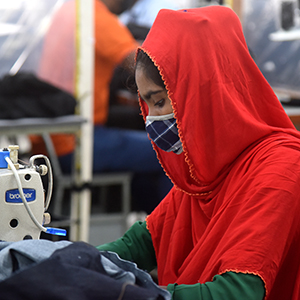Research: Impact of COVID-19 on Garment Industry
Study indicates manufacturers of some of the world’s most popular clothing brands have increased leverage within their industry.
Two professors of management at San Diego State University’s Fowler College of Business have recently published their findings on the long-term effects of the COVID-19 crisis on the supply chain for the manufacturers of some of the world’s most popular clothing brands.
SDSU’s Martina Musteen and Mujtaba Ahsan worked with Md Imtiaz Mostafiz at Sheffield Hallam University (UK) and Abrarali Saiyed at Özyeğin University (Turkey) to determine the immediate and long-term impact of the pandemic on the garment industry’s global value chain (GVC). They undertook 21 interviews with managers from seven garment manufacturing companies in Bangladesh during the height of the pandemic in May and June 2020, and again in May and June 2021, after most of the lockdowns spurred by the pandemic had been lifted.
The research was published in the Journal of Business Research in November 2021.

Professor Martina Musteen
Large Industry Suffers Major Setback at COVID-19 Crisis Onset
The researchers’ decision to study Bangladesh’s garment manufacturing industry as the setting for the pandemic’s impact
on the GVC (defined as the activities that bring a product from conception to end-use
and beyond) was motivated by their desire to learn more about the dynamics in one
of the largest industrial clusters in the world. Currently, the Bangladeshi garment
industry employs approximately 4 million workers and exports to more than 150 countries.
The industry suffered a major setback during the onset of the pandemic with the World Trade Organization reporting an 81% decrease in export orders in April 2020 compared to the same numbers
the previous year. Some of those orders would have typically come from customers that
include a number of the world’s most well-known clothing labels.
“We examined the Bangladeshi manufacturers of well-known brands such as ZARA, Disney, Next, H&M, Levi’s, Mossimo, Gap, Tommy Hilfiger, Ralph Lauren, Fila and Puma to determine how the sudden disruption of the COVID-19 pandemic impacted their business processes and the GVC,” said Musteen. “Specifically, we were interested in the outcomes that either permanently restructured the existing business routines or preserved/strengthened the existing business relationships within the period of that one year.”

Bangladeshi Factory Worker
Lockdown Cripples Suppliers
During the first round of interviews with the companies, the researchers learned that
the Bangladeshi manufacturers were obligated to purchase raw materials from specific suppliers
— primarily from China — as contractually agreed upon with their customers. The impact
of the Chinese lockdown became significant in January 2020 since shipments from China
were substantially delayed and prices showed a marked increase. Furthermore, all seven
companies were registered with the Bangladesh Garment Manufacturers and Exporters
Association (BGMEA) meaning they were strictly exporters and restricted from generating
revenue from customers within their home country.
Nearly all product orders for the seven companies were from European buyers and product orders were still strong through January. “As the pandemic escalated, its impact on every facet of the companies’ operations increased dramatically,” said Ahsan. “The difficulty in getting raw materials continued, but customers began cancelling orders or asking for discounts. Plus, new safety measures caused workflow disruptions, and there was a major increase in employee absenteeism, particularly among the unskilled workers. All of this caused a profound breakdown in the global supply chain.”
The effects of COVID-19 ratcheted up even more during the spring of 2020, when the major brand’s European buyers asked the seven manufacturers to stop production on large orders since they were now experiencing an oversupply of inventory. At the same time, the Chinese suppliers of the raw materials began demanding payments in 30 days instead of the traditional 60-to-90-day payment window.
The Government Steps In
With all of these factors bearing down on the manufacturers, the Bangladeshi government
stepped in to provide some relief through negotiating with the European customers,
various loans and a financial stimulus program that provided an incentive on exports
to customers outside the European Union (EU). They also withdrew demurrage fees and the value added tax on imported products,
including yarn and fabrics used by the manufacturers.
In addition, the manufacturers also started exploring new sales and supplier options. For example, some manufacturers pivoted their production to include healthcare products and began looking for new markets. “We started producing personal protective equipment (PPE) like facemasks and other health-related products in our factory before the lockdown,” said one manager. As they devoted new resources to find customers for their traditional product line (clothing) outside of the EU, many also sought qualified buyers for their new PPE-related product line and invested in more environmentally friendly technologies.
But perhaps the most important evolution was their customers’ loosening of contractual obligations on the specific Chinese suppliers of raw materials, which allowed the manufacturers the option of sourcing raw materials locally. With the added length of time required to get shipments of raw materials from outside the country during the height of the lockdown, customers began encouraging the manufacturers to look to Bangladeshi suppliers for materials, so long as the quality, cost, and delivery times were satisfactory.

Professor Mujtaba Ahsan
Massive Interruption Leads to Massive Industry Changes
As the researchers analyzed their data after the second round of manager interviews
in the spring of 2021, they were struck by how a massive disruption (in this case,
the COVID-19 crisis) led to long-term restructuring over a relatively short period
of time. Previous research on this subject indicated that evolution in most GVCs tends
to occur over years or decades. However, this study suggests that the Bangladeshi
manufacturers emerged from the lockdown in a more powerful position in the GVC than
before. They also observed that the strong governmental support and the willingness
on the part of the manufacturers to quickly adapt to their rapidly changing market
and update their capabilities helped to reshape the outcome.
One likely permanent change brought about by government incentives and the steep and sudden decline in sales compelled the manufacturers to expand their product lines to markets in the U.S., Canada, Japan, Middle East and Latin America. The researchers found that the manufacturer’s increased customer base and product lines offered them additional revenue, allowed them to streamline their markets with new technology and increased their labor force. “We have skilled people to do marketing, research, and new product development,” one manager told the researchers. “It gives us more options to develop a variety of products and enter more markets. We can control the whole process.”
While the aftermath of the COVID-19 pandemic prompted evolutions in the garment industry that were not previously foreseen, the researchers noted that the data also pointed to a “counterforce” that acted to strengthen the pre-lockdown GVC structure. “The existing suppliers of raw materials in China sought to deepen their bonds by resisting the trend to shorten payment terms and even sending PPE for factory workers,” said Ahsan. “We also noticed that the physical inspection of goods was highly curtailed in favor of digital communications, which increased efficiency and strengthened the relationship between the existing suppliers and the Bangladeshi manufacturers.”
Manufacturers Now in the Driver’s Seat
While initially subject to the worst impact of the pandemic, the Bangladeshi manufacturers
emerged from the crisis as more powerful. “We are no longer only a contract manufacturer
and we push our buyers through negotiations,” said one manager. “We are working with
new suppliers, as well as existing suppliers, but it’s our decision to source from
(existing) suppliers because they are offering better deals.”
“In conclusion, our research offered insight that in spite of the immense challenges and human suffering levied by COVID-19, the crisis offered opportunities to certain GVC actors, with the garment suppliers in Bangladesh as a prime example,” said Musteen. “However, this may not be true of all GVC sectors, especially those in more advanced economies and/or in industries with more government intervention. Future research should take into account the idiosyncrasies of each individual GVC and their role within their supply chain as they evaluate the impact of the COVID-19 crisis on the global business environment.”
Declaration of Competing Interest: The authors declare that they have no known competing financial interests or personal relationships that could have appeared to influence the work reported in this paper.

